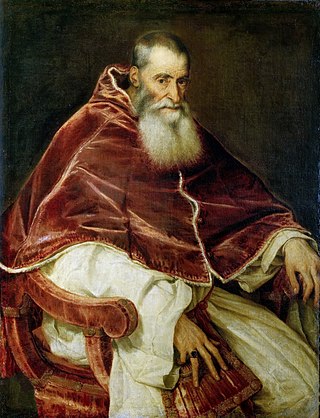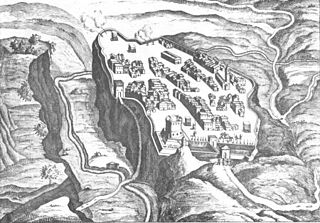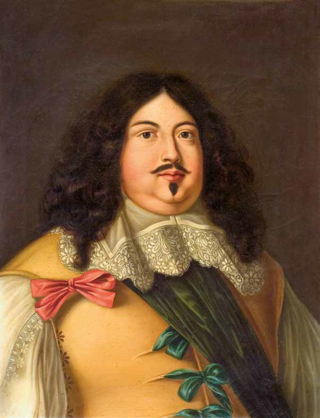
Castro was an ancient city on the west side of Lake Bolsena in the present-day comune of Ischia di Castro, northern Lazio, Italy. It was destroyed at the conclusion of the Wars of Castro in the 17th century.

Castro was an ancient city on the west side of Lake Bolsena in the present-day comune of Ischia di Castro, northern Lazio, Italy. It was destroyed at the conclusion of the Wars of Castro in the 17th century.
The settlement of Castro was founded in prehistoric times, and was later the seat of an unspecified Etruscan city, probably Statonia. In the Middle Ages it had a castle (Latin: castrum), hence the name. Although an autonomous commune, it remained nonetheless under papal suzerainty. In 1527 a pro-independence faction assumed power, but they were later ousted by Pier Luigi Farnese, whose family was to rule Castro until the 17th century. In the same year another Farnese, Gian Galeazzo, sacked it in the wake of the Sack of Rome.
Ten years later, in 1537, three years after the election of Alessandro Farnese as Pope Paul III, it became the seat of an independent duchy under his son Pier Luigi Farnese. The town, which in the meantime had been reduced to "gypsies' huts" (in the words of a contemporary), was reconstructed according to the design of Antonio da Sangallo the Younger.
The Farnese treated Castro well and consecutive family patriarchs made improvements to the city including churches and their own Palazzo Farnese.
Between 1639 and 1641, the Farnese, then led by Duke of Parma Odoardo Farnese, came into conflict with the powerful Barberini family of Pope Urban VIII who responded by sending an army to occupy Castro. The Farnese and the papacy fought a stalemate war and the Pope agreed to treaty terms only months before his death in 1644.
When Pope Innocent X replaced Urban, he demanded that Duke Odoardo's son Ranuccio II Farnese, Duke of Parma adhere to the conditions of the peace treaty. Ranuccio refused to pay the agreed reparations. He also refused to admit the newly appointed bishop of Castro. When the latter was on his way to take possession of his see, he was murdered, a crime for which Innocent X placed the blame on Ranuccio. He sent troops to Castro and had the city razed on 2 September 1649. He erected a column reading "Quì fu Castro" ("Here stood Castro"). It was never rebuilt. The seat of the diocese of Castro, which is believed to have dated back to the 8th century, was transferred to Acquapendente. [1] [2] No longer a residential bishopric, Castro (Castrum in Latin) is today listed by the Catholic Church as a titular see. [3]

Pope Paul III, born Alessandro Farnese, was head of the Catholic Church and ruler of the Papal States from 13 October 1534 to his death, in November 1549.

Ottavio Farnese reigned as Duke of Parma and Piacenza from 1547 until his death and Duke of Castro from 1545 to 1547 and from 1553 until his death.

The Duchy of Parmaand Piacenza, was an Italian state created in 1545 and located in northern Italy, in the current region of Emilia-Romagna.

Pier Luigi Farnese was the first Duke of Castro from 1537 to 1545 and the first Duke of Parma and Piacenza from 1545 to 1547. He was the illegitimate son of Cardinal Alessandro Farnese. He became a soldier and participated in the sack of Rome in 1527.

Ranuccio Farnese was an Italian prelate of the Farnese family, who was Cardinal of Santa Lucia in Selci from 1545 to his death in 1565. Son of Pier Luigi Farnese, the illegitimate son of Pope Paul III, Farnese was created Cardinal at the age of 15 by his grandfather the pope: he was nicknamed the cardinalino for his young age.

Ranuccio I Farnese reigned as Duke of Parma, Piacenza and Castro from 1592. A firm believer in absolute monarchy, Ranuccio, in 1594, centralised the administration of Parma and Piacenza, thus rescinding the nobles' hitherto vast prerogative. He is best remembered for the "Great Justice" of 1612, which saw the executions of a large number of Piacentine nobles suspected of plotting against him. Claudia Colla his mistress and her mother were accused of using witchcraft to stop him from having offspring, and both were sentenced to death by burning. Because one of the conspirators, Gianfrancesco Sanvitale, falsely implicated several Italian princes, namely Vincenzo Gonzaga, Duke of Mantua and Cesare d'Este, Duke of Modena, in the plot, Vincenzo and Cesare's names appeared on the list of conspirators during formal court proceedings; as a result, Ranuccio's reputation among the rulers of Italy was irreparably damaged because it was evident that he gave credence to Gianfrancesco's obviously false confession. When, consequently, in the early 1620s, Ranuccio was looking for a bride for his younger legitimate son and heir, Odoardo, none of the Italian ruling families were forthcoming with princesses.

Ranuccio II Farnese was the sixth Duke of Parma and Piacenza from 1646 until his death nearly 50 years later and Duke of Castro from 1646 until 1649.

The Wars of Castro were a series of conflicts during the mid-17th century revolving around the ancient city of Castro, which eventually resulted in the city's destruction on 2 September 1649. The conflict was a result of a power struggle between the papacy – represented by members of two deeply entrenched Roman families and their popes, the Barberini and Pope Urban VIII and the Pamphili and Pope Innocent X – and the Farnese dukes of Parma, who controlled Castro and its surrounding territories as the Duchy of Castro.

The House of Farnese was an influential family in Renaissance Italy. The titles of Duke of Parma and Piacenza and Duke of Castro were held by various members of the family.

Odoardo Farnese, also known as Odoardo I Farnese to distinguish him from his grandson Odoardo II Farnese, was Duke of Parma, Piacenza and Castro from 1622 to 1646.
Farnese may refer to:

The Shrine of Santa Maria della Steccata is a Greek-cross design Renaissance church in central Parma, Italy. The name derives from the fence in the church. A Nursing Madonna is enshrined within, crowned on 27 May 1601 by a Marian devotee, Fray Giacomo di Forli of the Capuchin order. Pope Benedict XVI raised the Marian sanctuary to the status of Basilica minor on 9 February 2008.

The Duchy of Castro was a fiefdom in central Italy formed in 1537 from a small strip of land on what is now Lazio's border with Tuscany, centred on Castro, a fortified city on a tufa cliff overlooking the Fiora River which was its capital and ducal residence. While technically a vassal state of the Papal States, it enjoyed de facto independence under the rule of the House of Farnese until 1649, when it was subsumed back into the Papal States and administered by the House of Stampa di Ferentino.

Taddeo Barberini (1603–1647) was an Italian nobleman of the House of Barberini who became Prince of Palestrina and Gonfalonier of the Church; commander of the Papal Army. He was a nephew of Pope Urban VIII and brother of Cardinals Francesco Barberini and Antonio Barberini. Thanks to their uncle's famous nepotism, the brothers shaped 17th-century Italian politics, religion, art, music and architecture.

Margherita de' Medici was Duchess of Parma and Piacenza by her marriage to Odoardo Farnese, Duke of Parma. Margherita was regent of Piacenza in 1635, and regent of the entire duchy from 1646 until 1648 during the minority of her son.

Luigi Mattei was an Italian military General and Marquis de Belmonte. During the 17th century he commanded troops loyal to the papal armies of Barberini Pope Urban VIII and Pamphili Pope Innocent X during the Wars of Castro.

Gerolama Orsini (1504–1569) sometimes Girolama Orsini was the Duchess of Parma as the wife of Pier Luigi Farnese, Duke of Parma. She served as Regent (Governor) of the Duchy of Castro in the name of her son Orazio, Duke of Castro between 1550 and 1553.

Francesco Maria Farnese was an Italian Roman Catholic cardinal.

Margherita Aldobrandini, was an Italian noblewoman member of the Aldobrandini family and by marriage Duchess consort of Parma and Piacenza during 1600–1622. She was also Regent of both Duchies during 1626–1628 on behalf of her minor son.
Ottavio Farnese was an Italian nobleman. He was an illegitimate son of Ranuccio I Farnese, Duke of Parma and Briseide Ceretoli, who was at that time unmarried; she was the daughter of Ottavio Ceretoli, a captain who had died in Flanders in the following of Alessandro Farnese, Duke of Parma. The couple also had an illegitimate daughter, Isabella.